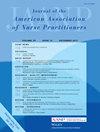Timing of stroke survivors' hospital readmissions to guide APRNs in primary care
IF 1.2
4区 医学
Journal of the American Association of Nurse Practitioners
Pub Date : 2024-05-03
DOI:10.1097/jxx.0000000000000984
引用次数: 0
Abstract
Caring for patients after a neurovascular incident is common for advanced practice registered nurses (APRNs). Most neurological readmission studies focus on a small subset of neurovascular incident groups, but advanced practice nurses in primary care attend to a diverse neurovascular population and lack time to adequately search hospital records. The aim of this study was to determine readmission risk factors after a neurovascular incident to guide APRNs in the primary care setting. The study is a retrospective observational study that used a crude single predictor model to determine potential risks for readmission. A total of 876 neurovascular participants were studied. Of these, only 317 experienced at least one hospital readmission, with 703 readmissions within 1 year, indicating some were readmitted more than once. Risks for readmission varied across neurovascular events. The main reasons for readmission were because of neurological, cardiovascular, and musculoskeletal complications. Stroke readmission rates are high and require intervention by APRNs. To prevent readmission includes timely follow-up within 30 days and should also include longitudinal follow-up beyond 90 days to prevent hospital readmission. Future studies are needed to create guidelines for APRNs that implement rehabilitation strategies to decrease hospital readmission for the neurovascular population that focus on interdisciplinary communication.中风幸存者再入院的时间安排可为全科护士提供指导
对高级执业注册护士 (APRN) 来说,在神经血管事件发生后护理患者是很常见的事情。大多数神经科再入院研究都集中在一小部分神经血管事件群体,但初级医疗保健中的高级执业护士要照顾的神经血管事件群体多种多样,而且没有时间充分搜索医院记录。 本研究旨在确定神经血管事故后的再入院风险因素,为初级医疗机构的高级护理师提供指导。 该研究是一项回顾性观察研究,采用粗略的单一预测模型来确定再入院的潜在风险。 共有 876 名神经血管参与者接受了研究。其中,只有 317 人至少经历过一次再入院,703 人在一年内再入院,这表明有些人再入院不止一次。不同神经血管事件的再入院风险各不相同。再入院的主要原因是神经、心血管和肌肉骨骼并发症。 脑卒中再入院率很高,需要全科护士进行干预。预防再入院包括 30 天内的及时随访,还应该包括 90 天后的纵向随访,以防止再入院。 未来的研究需要为全科护士制定指导方针,实施康复策略以减少神经血管人群的再入院率,重点是跨学科沟通。
本文章由计算机程序翻译,如有差异,请以英文原文为准。
求助全文
约1分钟内获得全文
求助全文
来源期刊

Journal of the American Association of Nurse Practitioners
Nursing-General Nursing
自引率
16.70%
发文量
172
期刊介绍:
The Journal of the American Association of Nurse Practitioners (JAANP) is a monthly peer-reviewed professional journal that serves as the official publication of the American Association of Nurse Practitioners.
Published since 1989, the JAANP provides a strong clinical focus with articles related to primary, secondary, and tertiary care, nurse practitioner education, health policy, ethics and ethical issues, and health care delivery. The journal publishes original research, integrative/comprehensive reviews, case studies, a variety of topics in clinical practice, and theory-based articles related to patient and professional education. Although the majority of nurse practitioners function in primary care, there is an increasing focus on the provision of care across all types of systems from acute to long-term care settings.
 求助内容:
求助内容: 应助结果提醒方式:
应助结果提醒方式:


